“I said giant, I didn’t say sleeping giant, it’s just a giant,” barked the new Shelbourne manager Damien Duff at a reporter whilst being interviewed at the launch of the League of Ireland 2022 season back in February.
In October 2021, followers of Irish football were left shellshocked when Shels announced that Ian Morris would step down from his position at Tolka Park after the final game of the 2021 season. Morris led the Dublin-based club to two promotions from the First Division, walking away with his head held high and a 67 percent win record to his name.
Within a matter of days, former Chelsea, Newcastle United and Fulham winger Duff was appointed to the dugout as Morris’ successor, taking a giant leap of faith into his first senior management role.
The young coach got to work straight away, cutting the team’s post-season break short and bringing a plethora of fresh, young talents with him including Arsenal loanee Jordan McEneff and Wales Under-21s international Jordan Webb.
So far, Duff’s stint has been relatively awkward. The not-so-asleep giants have won just once under the new head coach in seven league matches, scoring merely four goals.
This article will be a tactical analysis of Shelbourne under the new man. It will be an analysis of the side’s tactics, focusing on some of the key tactical components Duff has been trying to integrate early on.
Formations and style of play
During his playing career, Duff was managed by some of the titans of the football world. The former winger had the pleasure of working with Roy Hodgson, Claudio Ranieri, Jose Mourinho and Giovanni Trapattoni throughout his illustrious playing days.
As little had been known about Duff’s coaching philosophy on the pitch, many were anxious to find out exactly how Shelbourne would play.
Since his arrival, Duff has been keen to implement a back three system. In every game so far, Shels have set up in a variation of a three at the back system. In his first few matches, the 43-year-old had opted to deploy a 3-4-2-1 but injuries and a slight need for more defensive security has seen the coach cede the structure into more of a 3-5-2/3-4-1-2.
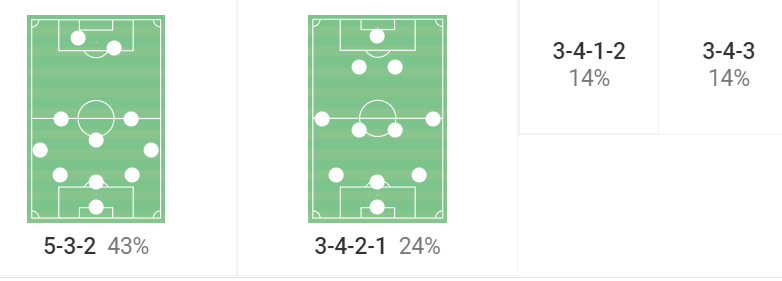
Duff’s side have been playing quite a strange hybrid of football since his arrival in the dugout. Shelbourne tend to sit back in a 5-3-2 low block for large parts of games, particularly against better opposition, but there is also an emphasis on modern principles of play such as playing out from the back and employing a possession-based system in possession.
The main issue that Shelbourne is facing is quite simple. The team are not very good on the ball. Trying to play a sumptuous possession-oriented style is certainly admirable on Duff’s behalf. However, having a plan and actually executing it are two strikingly different things.
The Reds are like a beautifully refurbished car. There are some brand-spanking new wheels, and the driver is full of enthusiasm and hope for the future. But there’s no fuel in the car. This is Shelbourne Football Club in its current state.
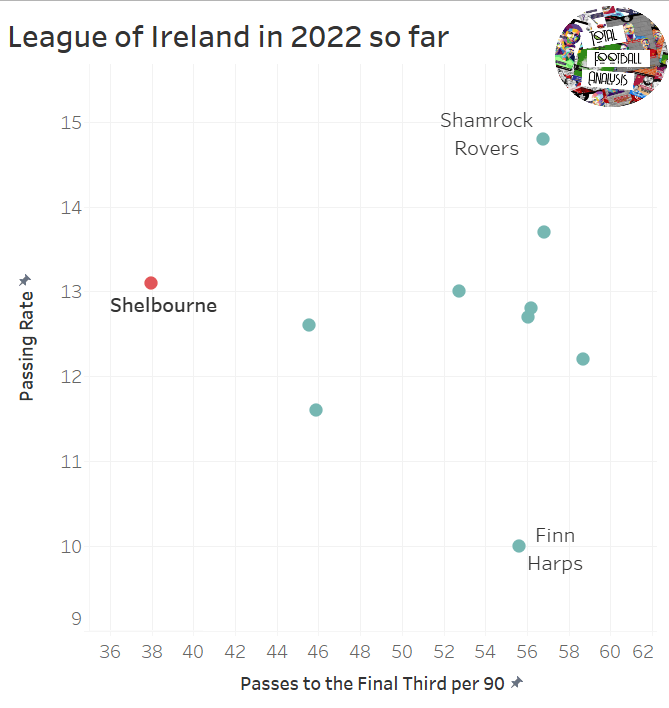
This data graphic tells you all you need to know. So far, Shelbourne have the third-highest passing rate in the League of Ireland with 13.1. Passing rate measures how many passes a team makes per minute of ball possession. Only Derry City and champions Shamrock Rovers have bettered this.
Nevertheless, Shels also have the lowest number of passes to the final third per 90 with 37.97, meaning that Duff’s boys are holding the ball relatively well during the attacking phases but are really struggling to progress it from back to front. It’s possession without purpose.
Building out from the back
It’s still early days yet but it has been quite difficult to pinpoint Shels’ attacking philosophy under Duff. The Reds have looked to play out from the back at times but often a long ball to the centre-forwards is the go-to option depending on how high the opposition is pressing.
When playing out from the back using three central defenders, there are numerous ways to position the centre-backs. Certain managers prefer one of the wide central defenders to position themselves at the side-line as an auxiliary fullback, which creates somewhat of a temporary back four.
For instance, here is an example of Internazionale’s structure in the build-up phase under Antonio Conte last season:
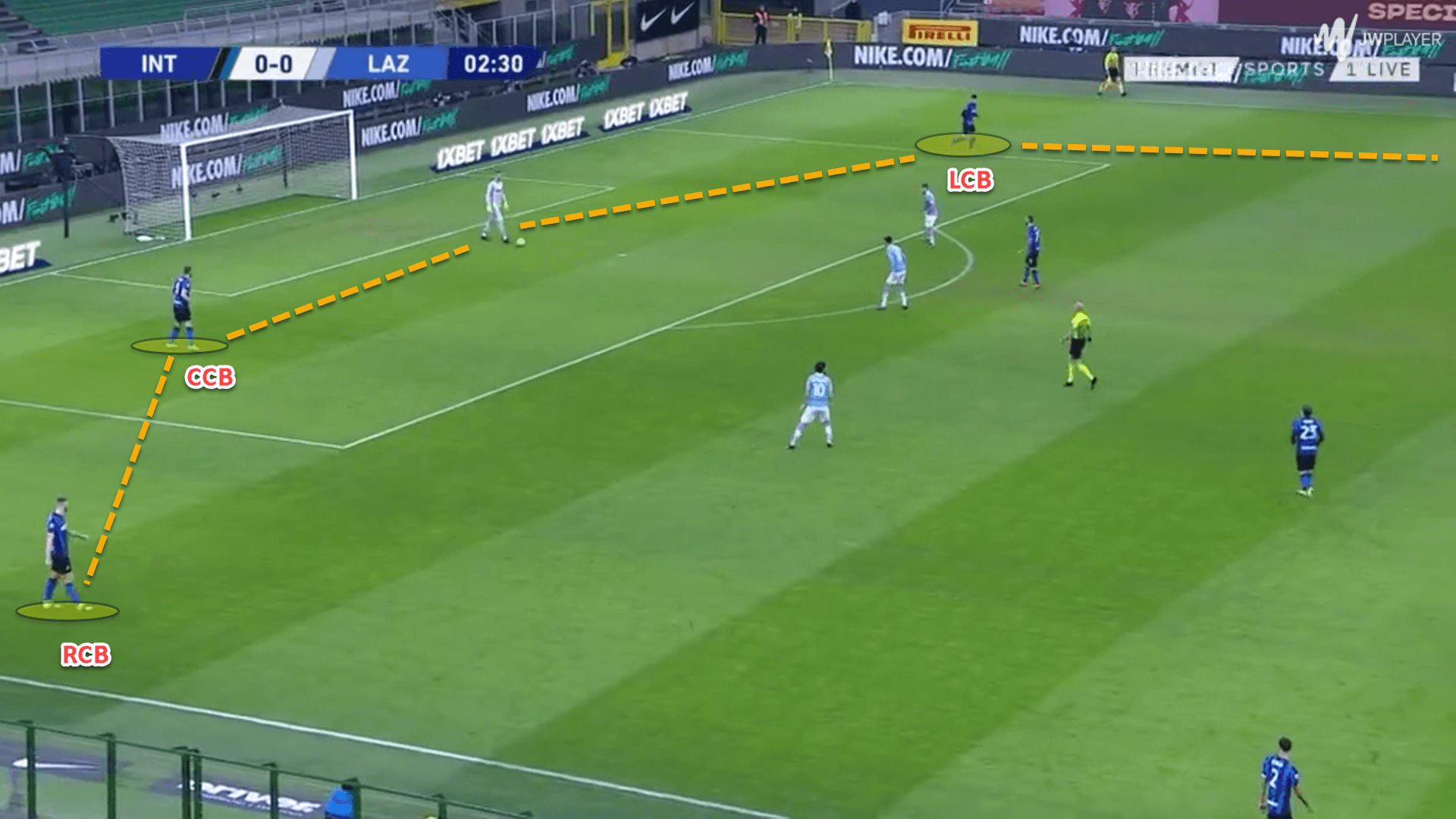
Duff hasn’t abided by these rules and instead has instructed his centre-backs to remain extremely close together in the deeper areas of the pitch.
Often, all three will be inside the penalty area in close proximity to one another as well as the goalkeeper. This allows the passing distance to be shorter too, making it less likely for a pass to be misplaced, essentially reducing the margin for error.
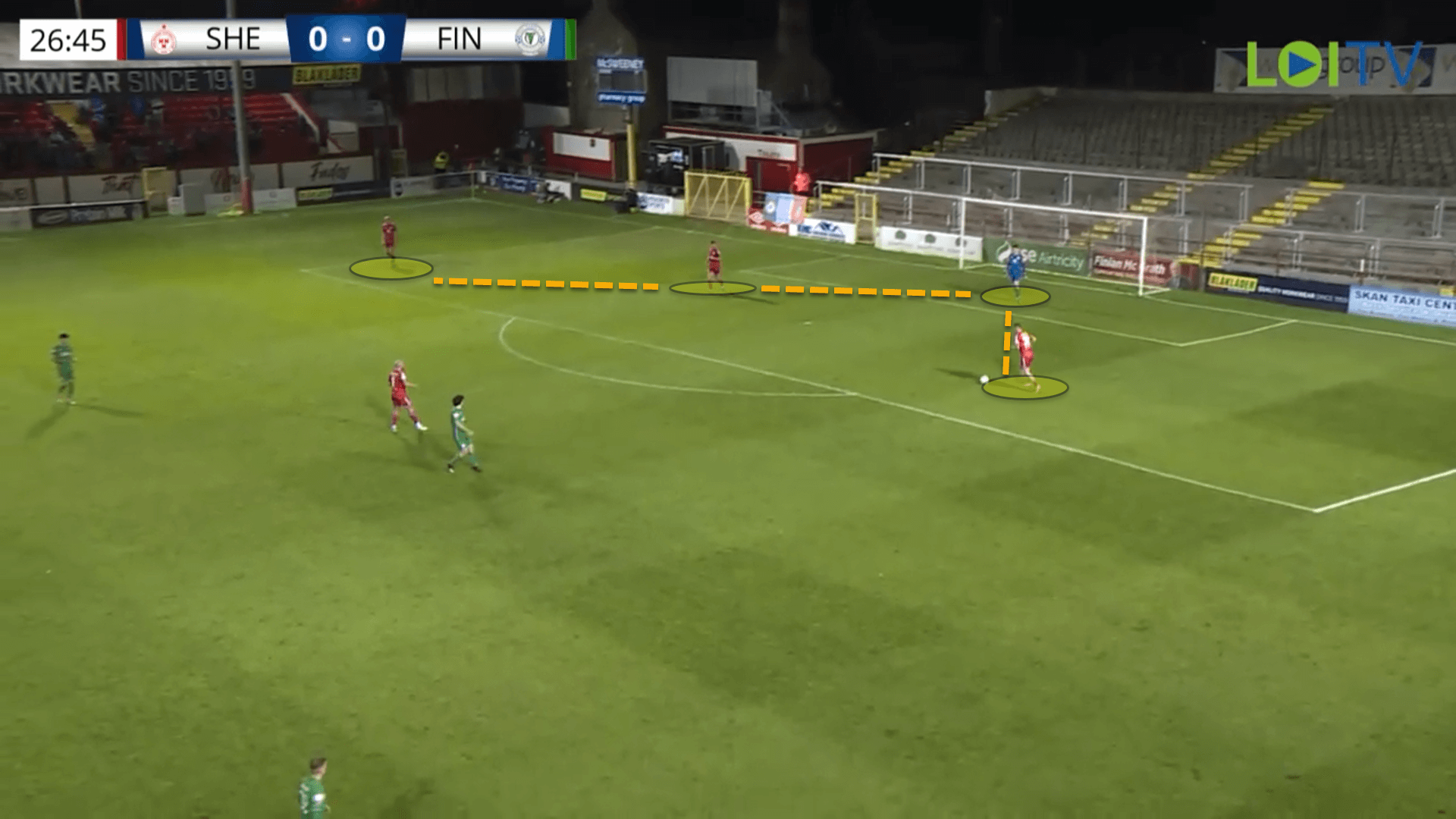
The quality of defenders at the club is solid after some investment in the transfer window, bringing in former Manchester City academy player Aaron O’Driscoll as well as re-signing the ex-Southampton youth player Kameron Ledwidge.
However, while being as respectful as possible, Duff is astute enough to know that perhaps the technical quality is lacking in the defensive department. The risk of making a poor pass while trying to build up from the first third is inherently real at the newly-promoted side.
Keeping the centre-backs close together has become a noticeable pattern of Shels’ play in possession. In case the ball is lost, or a poor pass is made, the three defenders are already near each other to quickly regroup and quash any central space.
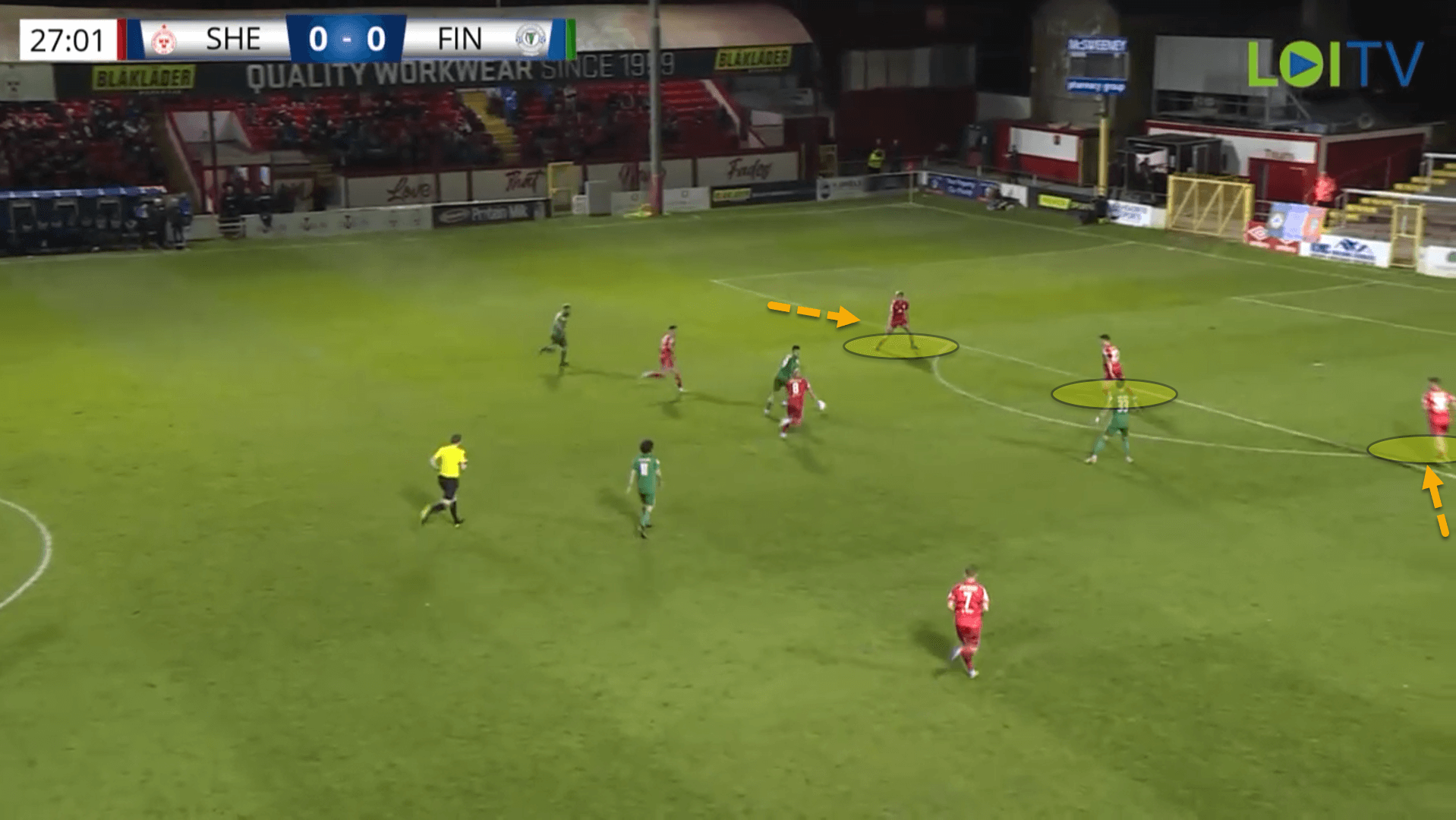
Here, a sloppy pass was attempted whilst the side were trying to play up the pitch from deep. The centre-backs, having already been closely distanced, were quickly able to bunch together and stop the transition in the end, killing Finn Harps’ dangerous attack.
There are limitations to having your central defenders so close together though. In Shelbourne’s case, as they deploy quite a narrow formation where the wingbacks are the only source of width on the flanks, forming consistent passing networks between a wide centre-back and a wingback can be difficult.
Basically, if a wingback is very high in the wide areas and a central defender is narrow and more central, passing between these two is considerably more arduous as each pass will require immense precision which can be hard to come by in the League of Ireland.
As a result, the ball-near wingback will usually drop shorter to receive but this is easy to defend against and means that they now have one less player in an advanced position.
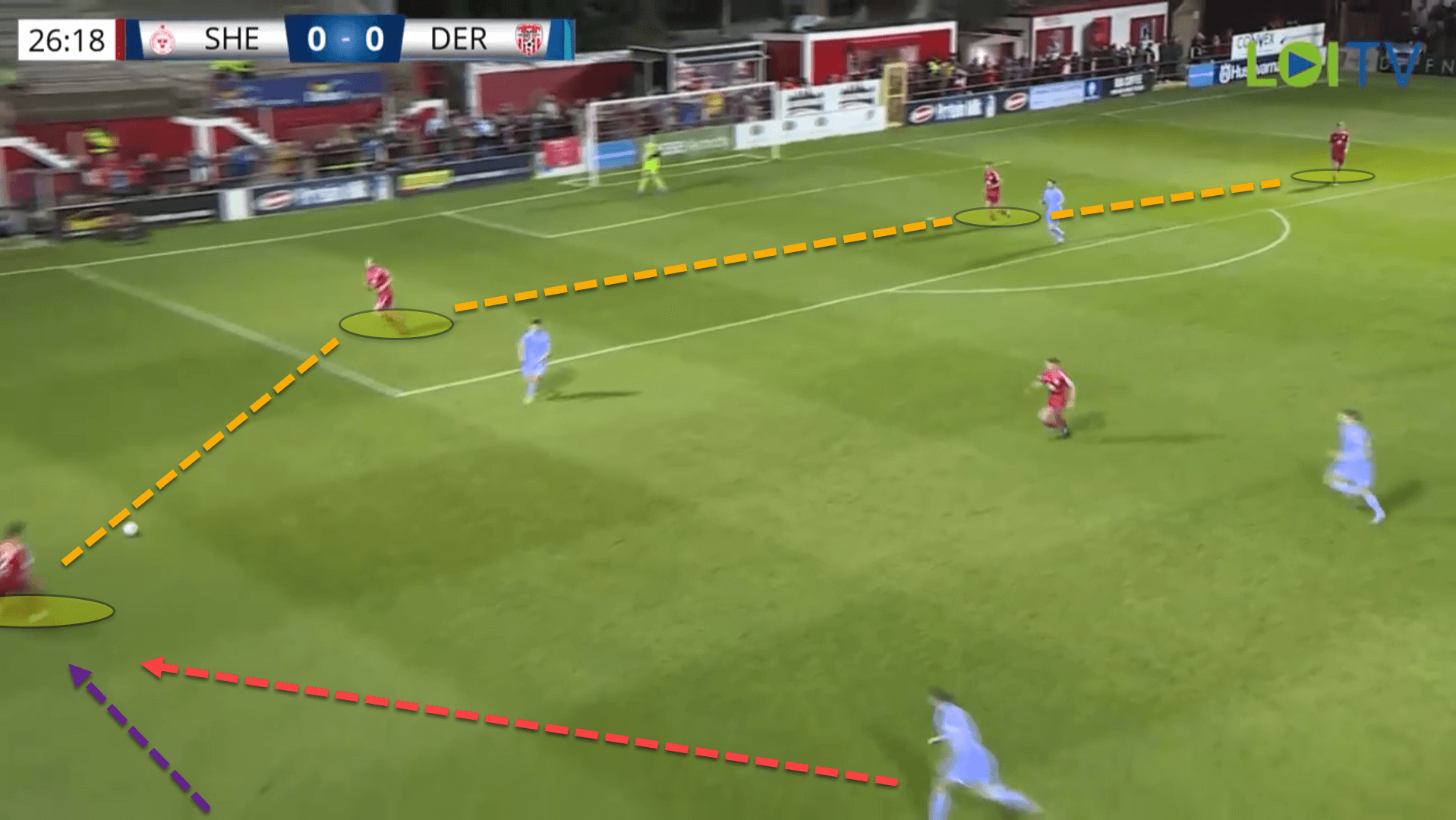
This has led to a clear issue surrounding ball progression. Shelbourne are currently averaging 63.2 attempted progressive passes per 90 in the League of Ireland, according to Wyscout. This is the second-lowest in the division with only UCD displaying a worse tally.
Adding more fuel to the roaring fire, Shelbourne’s accuracy on these passes is merely 61.7 percent. Again, this is the second-worst in the league. The Reds aren’t attempting many progressive passes and when they do, these passes aren’t efficient.
Breaking down a defensive block
Ultimately, while ball progression continues to be a struggle for Shelbourne, the Dublin team have shown a tendency to attack down the flanks. This is mainly because of a lack of technical quality and press resistance in the midfield.
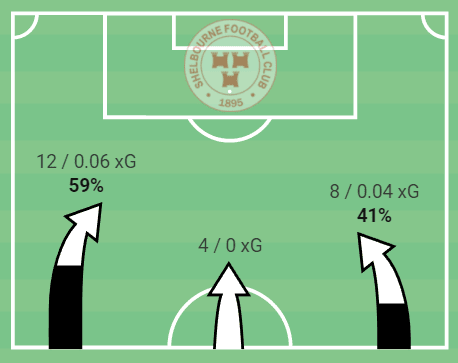
This data visual portrays all of Shelbourne’s 24 positional attacks from a 3-0 loss against Finn Harps last week. 20 were down the flanks with just 4 coming from the central corridors.
One of the key ways that Duff’s side look to reach the final third and break through an opponent’s defensive block is by having one of the central midfielders making runs in behind.
There is a trigger for this though. In the previous section, it was mentioned that the ball-near wingback drops short to receive a pass from the centre-back in deeper areas of the pitch. While this may limit the possibility to get a wide player into a dangerous attacking position, it does create the potential for someone to take advantage of the space left behind.
This is because when the wingback drops short, his opposite number follows suit. This leaves space for an attacking player to move into. The central midfielders are the ones instructed to attack this area.
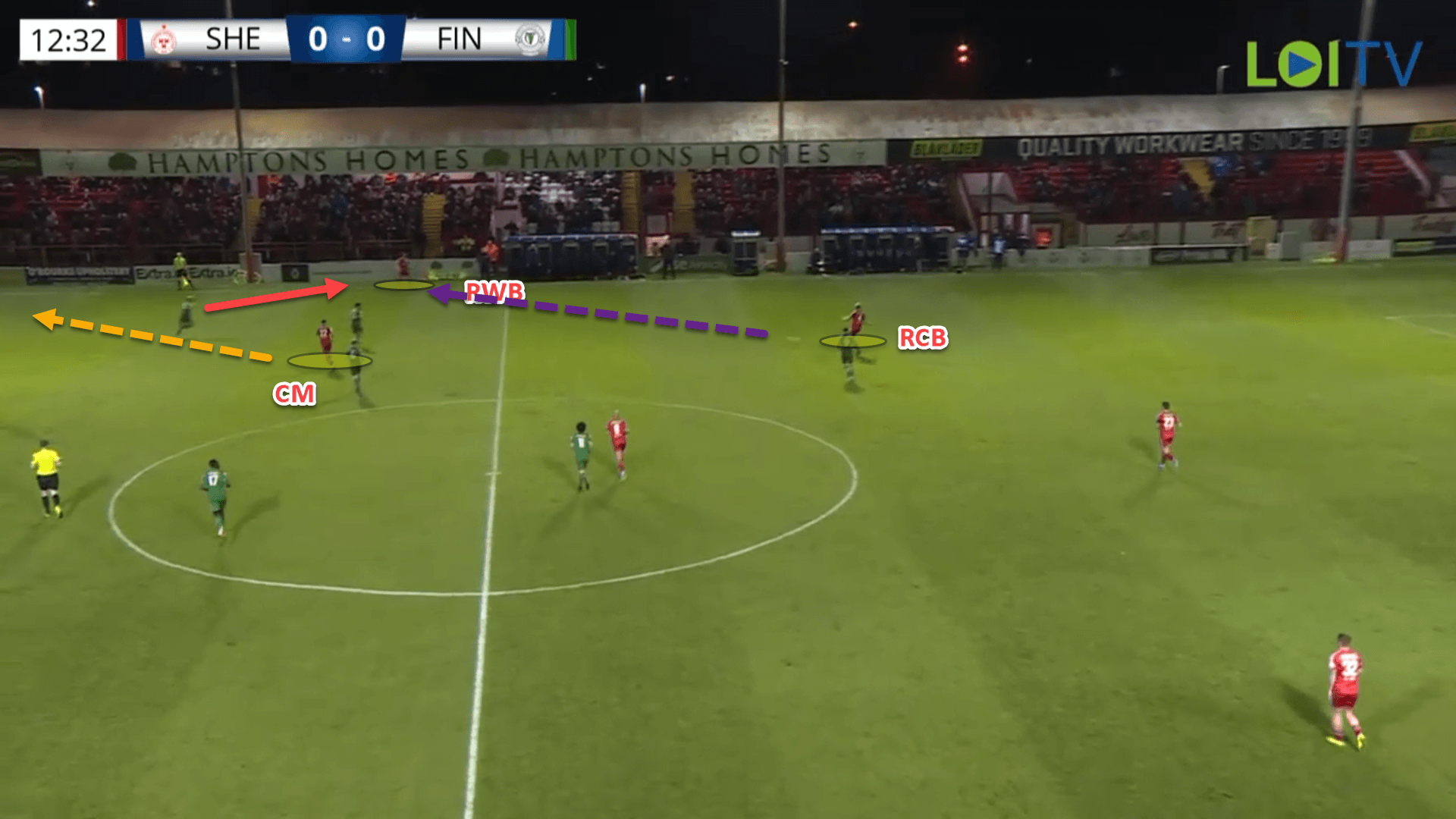
In this example, the right centre-back O’Driscoll has played out to JR Wilson, the Shelbourne wingback. The opponent’s fullback steps out to close Wilson down upon reception of the ball. However, doing so leaves space down the sides and one of Shelbourne’s double-pivot on the day, McEneff, attacks this exploitable space.
Here, the move never came to fruition. The reason was that the pass from the centre-back to the wingback was poor as was the touch which was also spoken about in the previous section. Had Wilson been able to open his body up and play down the line, Shelbourne could have successfully cracked the defensive block, progressing to the final third in the process. Ultimately, this is the end goal, but the execution has been off.
At one point early in the second half against Derry City three weeks ago, in yet another home defeat, Duff was noticeably incensed at one of his wide central midfielders not making these runs in behind. While the blueprint of what he’s trying to implement is there, oftentimes Shelbourne’s shape in possession is extremely narrow and far too isolated from the forward line.
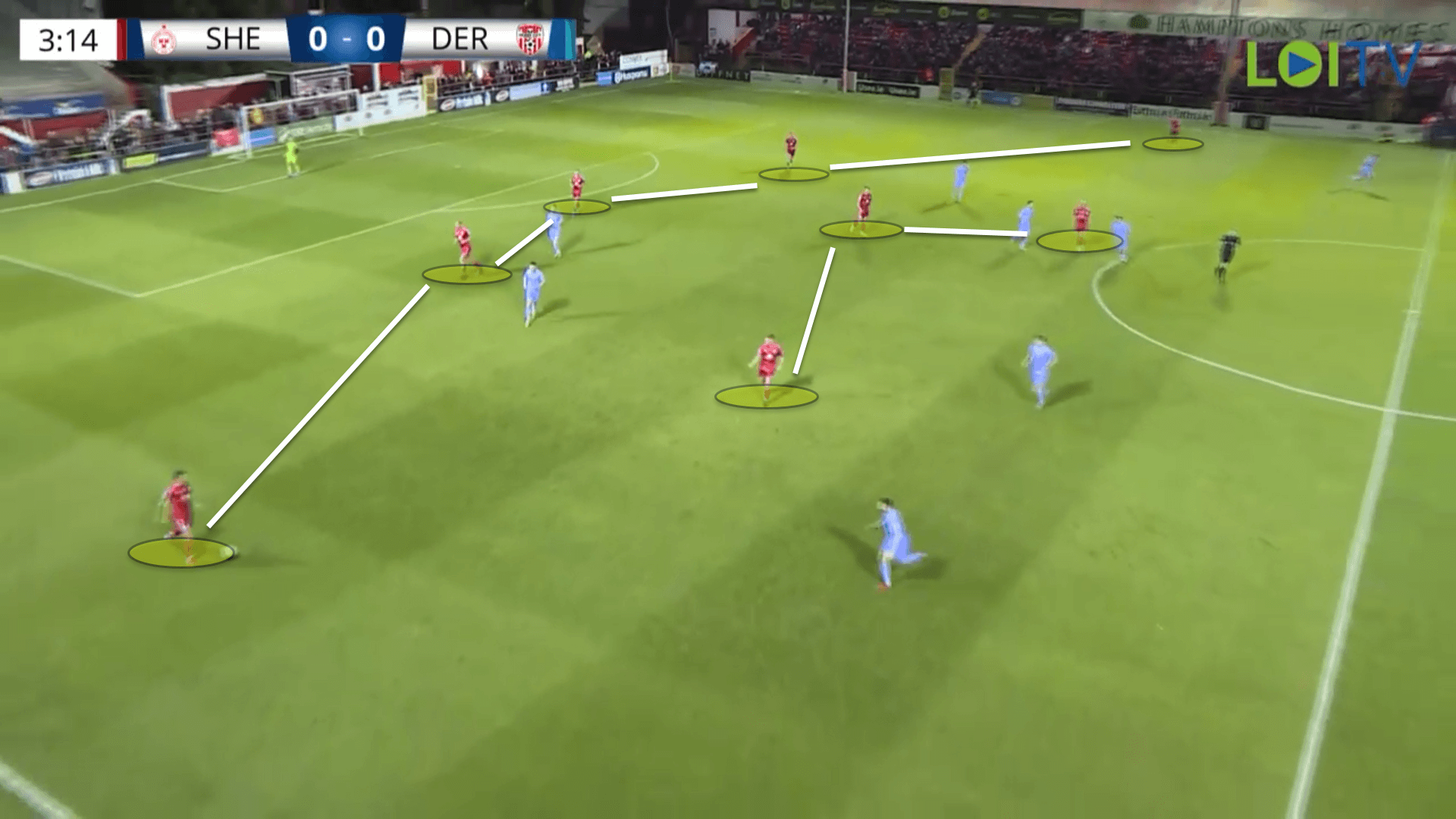
Looking at this example, there is no depth and very little width. The fullbacks are both low and not one single central midfielder has pushed up between the lines, leaving no possibility for the team to link play with the two strikers.
It’s admirable what Duff is doing, trying to keep the distance between the players at a minimum to make passes easier which facilitates for much more efficient counterpressing. However, this comes at a cost of any real attacking threat.
The only method of getting into the final third that has worked consistently for the Reds has been hitting long balls to the frontmen.
There is no issue with this. Sean Boyd and Dan Carr were signed before the season commenced with each being comfortable at challenging in the air and winning flick-ons for a runner in behind.
In the Dublin derby recently against Bohemians, Shels executed this well. Carr, and later Boyd who was substituted on in the second half, were constantly beating Bohs’ defenders to direct passes up the pitch which allowed the young and pacey Shane Farrell to latch onto second ball flick-ons.
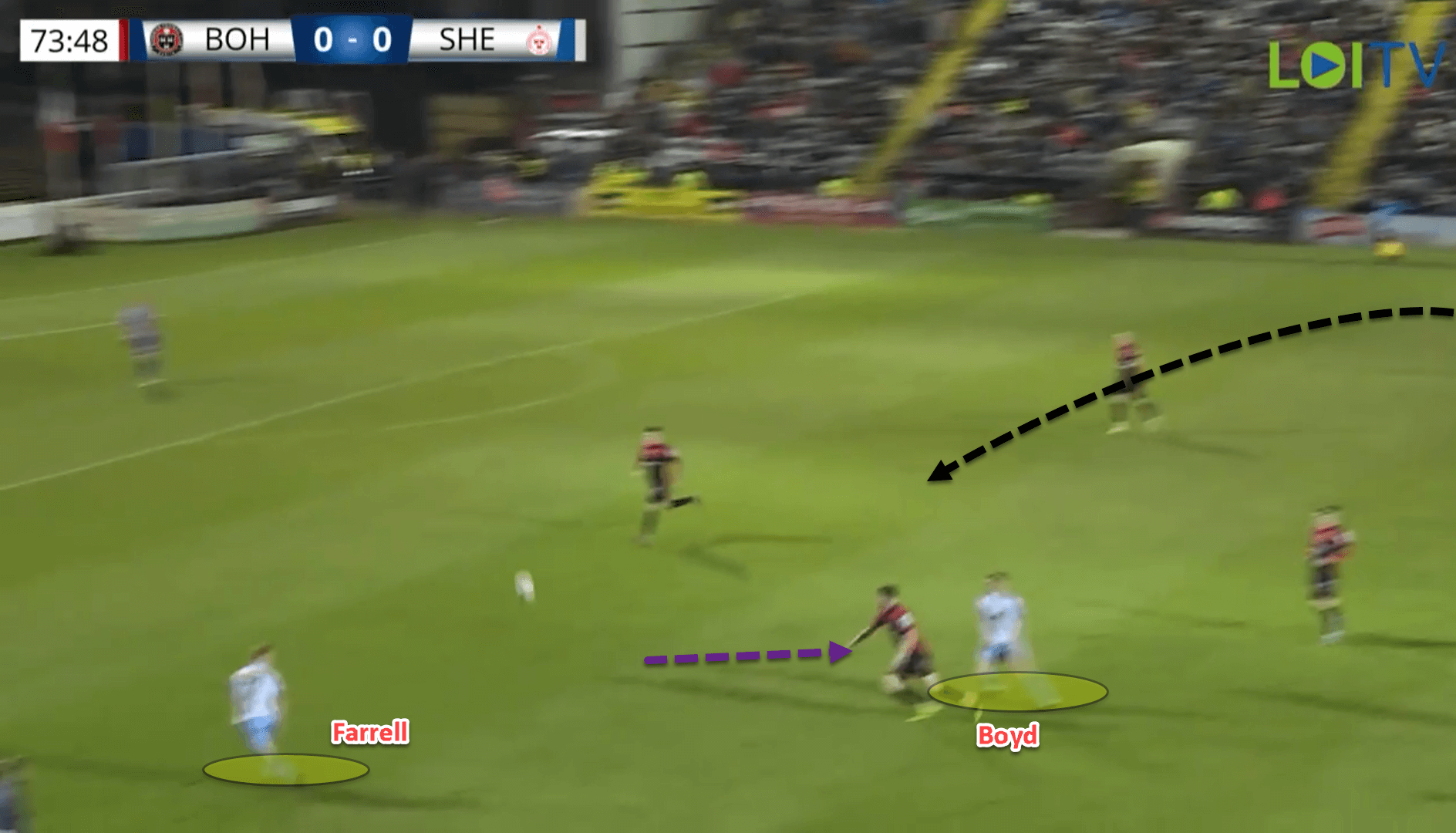
This led to the opener which earned Duff’s men a vital point against their bitter rivals. The goalkeeper pumped it long towards Boyd who challenged in the air with Bohs’ defender. Neither won the ball but it did bounce over both and into the feet of Farrell. The Finglas-born attacker carried it into the box, crossed to Boyd who tapped home with a lovely finish from his first touch of the game.
Long balls are not pretty. Unless you’re a masochist, very few have watched Burnley under Sean Dyche and were awed by the poetic style of football on display. Nevertheless, as proven by the Clarets, direct football can be effective when perhaps the technical quality is lacking.
Duff probably doesn’t want to coach a long pass-oriented team in the long-term but in the short-term, going direct seems like the best route for Shelbourne to actually create chances, an area they have severely struggled with.
Defensive style of play
On his debut against St. Patrick’s Athletic, Duff had set his side up to press high. Carr was leading the press on his own and Shelbourne’s 3-4-2-1 on the day fell into a 5-4-1 with the inverted wingers pushing slightly wider to press the fullbacks.
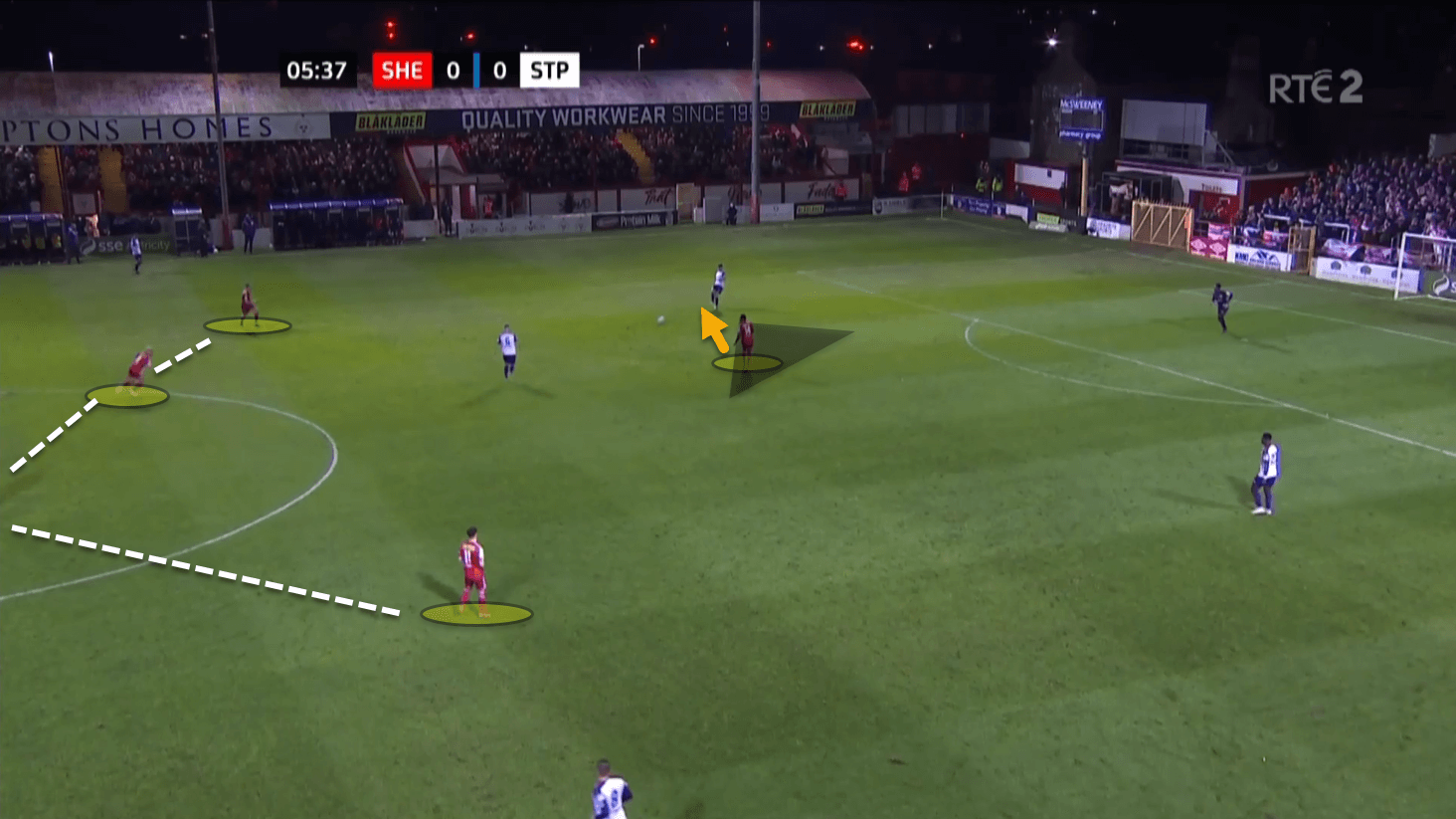
Carr’s role was to press St. Pats’ two centre-backs one at a time while shaping his pressure to block off the passing lane into the other. There seemed to be quite a lot of breaking down of the press though.
Given there was nobody else helping the striker in this phase, it became relatively easy for Pats to simply play into their pivot players. Once this occurred, one of Shelbourne’s two central midfielders would step out and apply pressure but it was often too late.
Duff’s side lost 3-0 on his debut and what proceeded over the following few weeks was a much more conservative approach from the Mourinho-disciple.
Shelbourne began pressing less and now tend to engage with the opposition at around the halfway line. Instead of attempting to win the ball high up the pitch, they sit in a deeper 5-3-2 defensive block, preventing the opposition from playing through them centrally.
Their principles are constant. Force the opponent out to the sides, deny any space inside the block, and then try and win the ball in these wide areas.
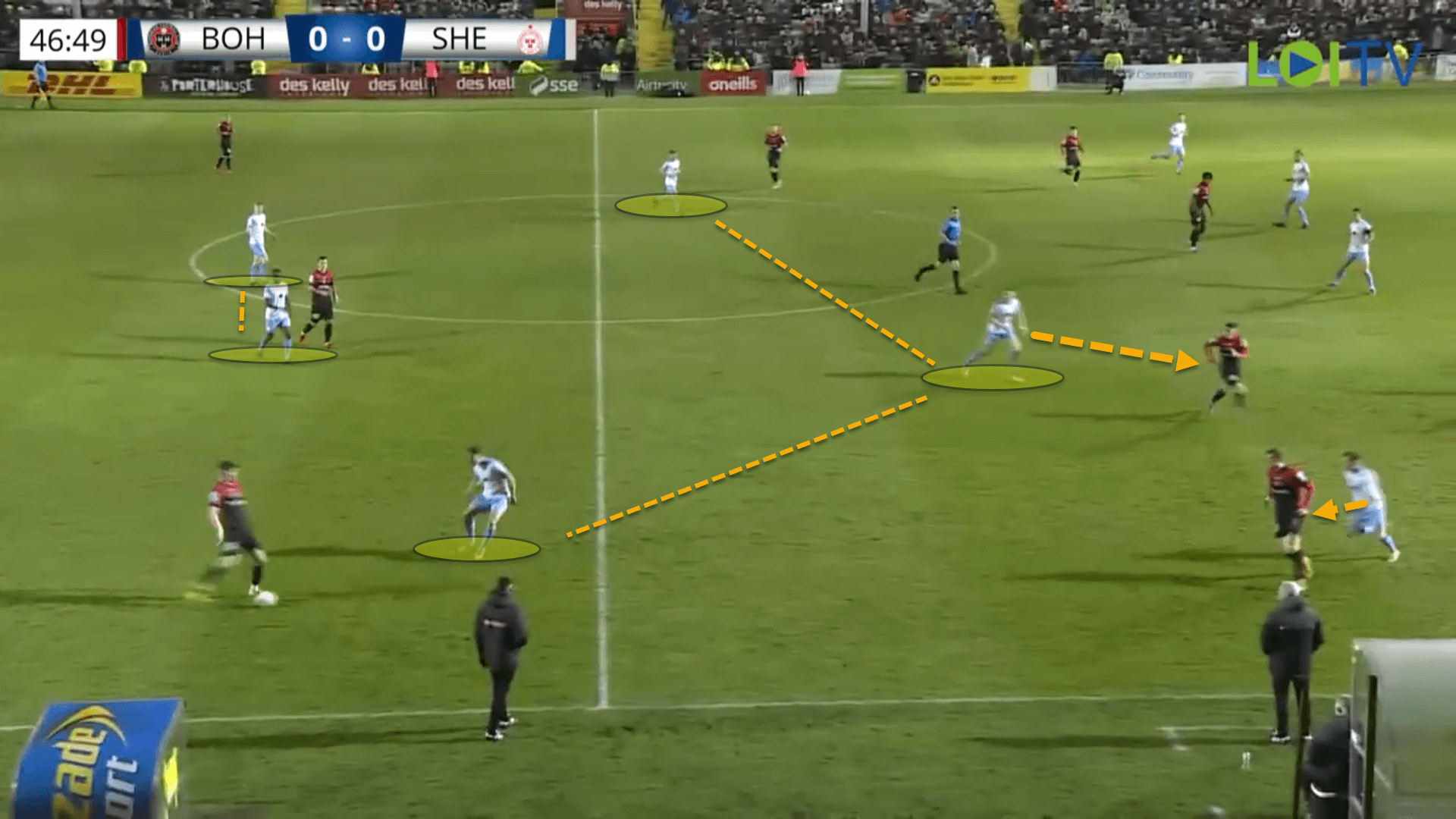
This type of structure is what’s known as a zonal block in coaching culture. Essentially, the defending team will stay extremely compact horizontally and vertically while allowing the opponent to play to the areas around their block.
However, once the ball is played inside the zonal block, they will look to pounce to regain possession as quickly as possible or else try and force them back outside to harmless areas. If needed, the centre-backs will step out of the defensive line to close down the player inside the block.
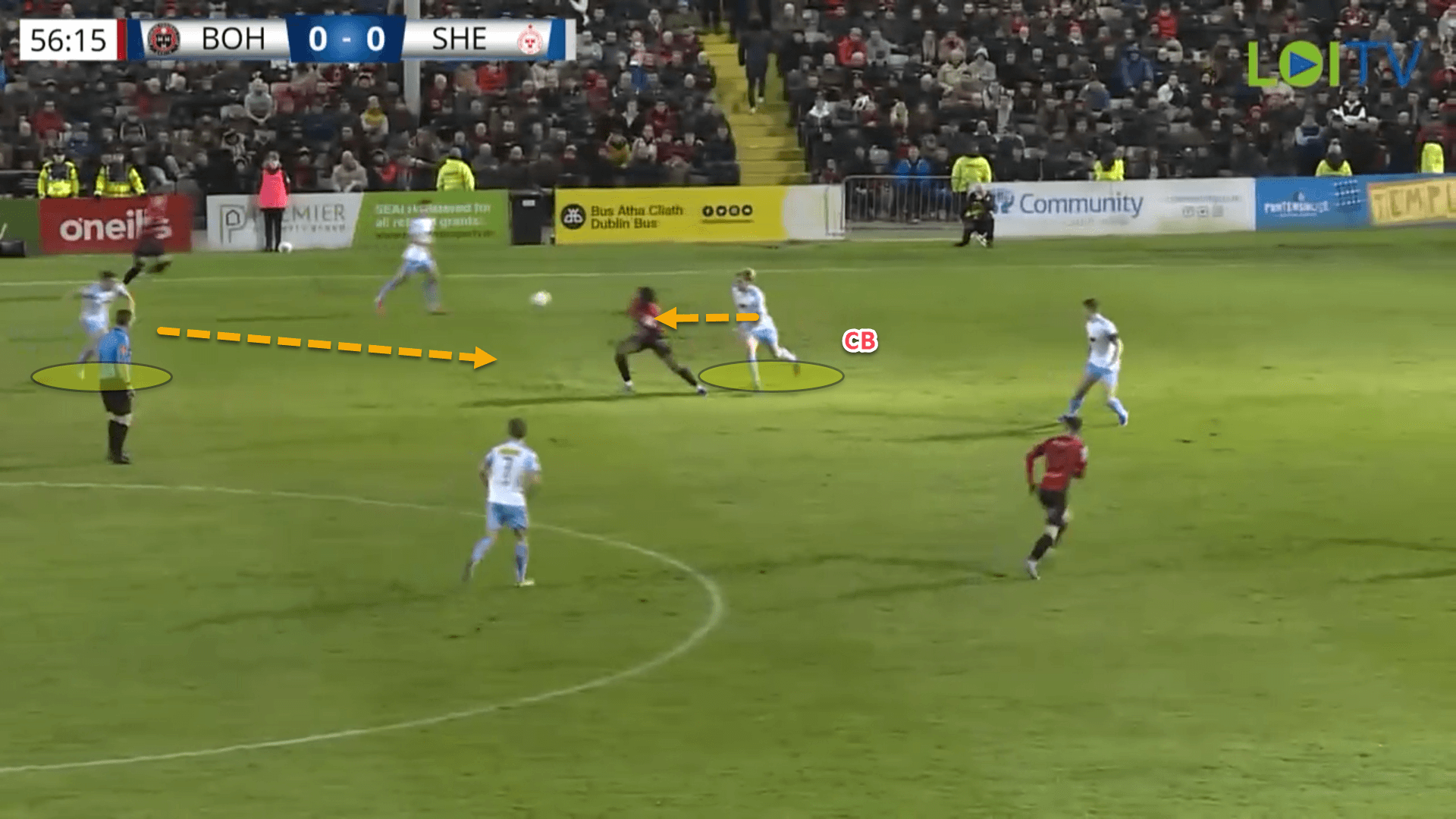
Observing the data available from Wyscout, Shelbourne have certainly not been passive in their defensive approach this season by any stretch of the imagination. Nonetheless, the Dubliners do still rank rather low in comparison with the rest of the division in terms of their Passes allowed Per Defensive Action average as well as their challenge intensity.
PPDA does what it says on the tin. Shelbourne are currently letting their opponent play 8.97 passes on average before making a defensive action. With PPDA, the lower the number, the better. Meanwhile, challenge intensity measures how many defensive actions a team makes every minute that the other side have possession.
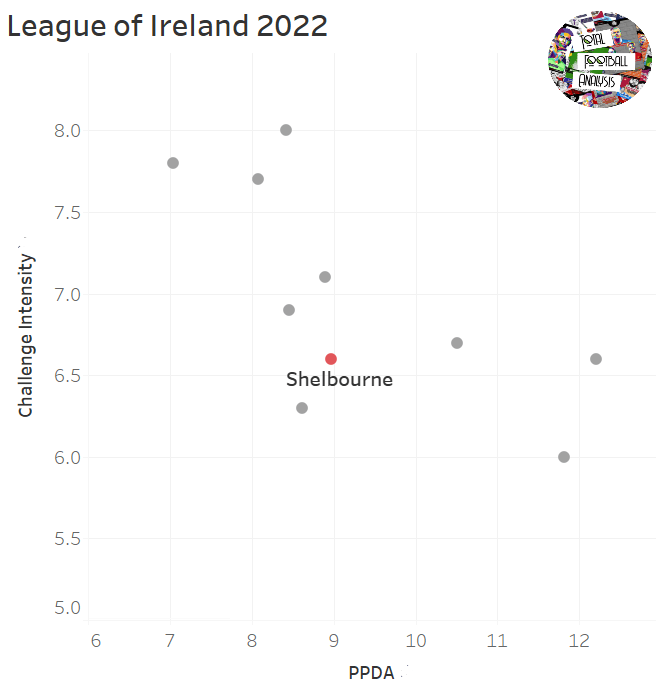
Shelbourne’s challenge intensity currently stands at 6.6. Looking at this graphic, Shels’ PPDA is high in contrast to the rest of the league while their challenge intensity is one of the lowest.
Conclusion
Duff’s side are averaging quite poorly in defensive metrics as well as offensive. The eye test backs up the point that the Reds are struggling while having just one win all season rounds off a rather bleak beginning to the campaign.
Nonetheless, there is no need to panic just yet. Duff has a wealth of experience playing at the highest level but is a rookie on the sidelines for now. Hopefully, when he finds his feet in terms of how he wants the side to play and the players start getting to grips with the system, Shelbourne will be able to stave off another impending relegation.
Shelbourne is meant to be a giant, not a sleeping giant. If that’s the case, it’s time for them to prove to the nation that they have finally woken up.






Comments